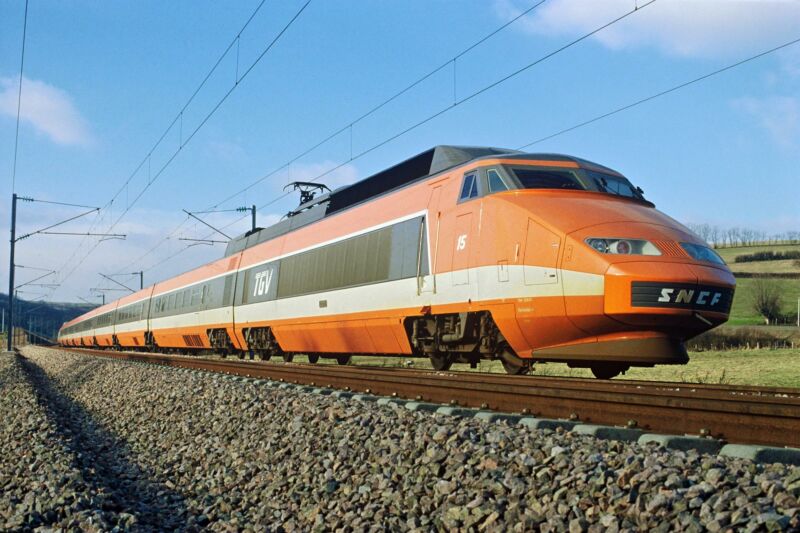
Every year, the Journées Européennes Patrimoine (European Heritage Days) weekend in September offers visitors a chance to visit numerous monuments all over Europe. Among the attractions in Paris this year was an orange-colored electric train with a name that has become a byword for speed and cutting-edge technology: the TGV. Thousands of enthusiasts flocked to the Gare de Lyon station to see the inaugural TGV (Train a Grande Vitésse), which was launched 40 years ago in September 1981.
Jacques Ruiz, one of the two drivers who piloted the first train 40 years ago, was at the Gare de Lyon station during the European Heritage Days weekend. “What impressed me most about the TGV was its aerodynamic design. The other locomotives, which looked like cubes, did not have such a shape. Of course, the power and the comfort of the air-conditioned cabin were impressive, too. It was exciting to drive this new train,” the 79-year-old said.
The first train was flagged off by the then French President François Mitterrand on September 22, 1981, and the first Paris-Lyon line was opened to the public five days later.
Built for speed
The first TGV, with a maximum speed of 260 km/hour, reduced the travel time between Paris and Lyon by one hour (from 3 hrs 40 minutes to 2 hrs 40 minutes). The present-day TGV, which reaches a maximum speed of 320 km/h, covers the same distance in just under two hours.
As the TGV network spread across France in the ensuing years, the travel times between other cities also dropped significantly. “This made it possible to do a return trip between French cities on the same day (Paris-Marseille in three hours, Paris-Bordeaux in two hours, Paris-Lille in one hour),”said François Vielliard, of the French railways (SNCF). “The TGV shrunk France as well as a few other European countries.”
-
The launch of the TGV service was a major public event in France.
-
The first TGV at the Gare de Lyon.Dhananjay Khadilkar
-
Visitors queue to see the driver’s cabin of the first TGV.Dhananjay Khadilkar
-
The TGV established a new record of 380 km/h in February 1981.Dhananjay Khadilkar
-
The present-day TGV still shares many features with the first.
-
The TGV helped inspire other high-speed rail, like the Eurostar.
The success of the TGV in France led to the development of high-speed lines in Switzerland, Germany, Spain, Italy, Belgium, Netherlands, and the UK, bringing Europe closer. For example, the travel time between Paris and London is 2 hours and 15 minutes, Paris to Zurich is 4 hours, Paris-Brussels 1 hr 30 minutes and Paris-Frankfurt 3 hours 45 minutes.
According to Eric Alexandre, who is an engineer and a driver at SNCF, the other distinctive aspect of the TGV is its affordability. “The TGV was meant for everyone and not just the rich.”
The speed, comfort, and affordability made the trains popular in no time. By the end of the 1980s, the high-speed trains ferried an average of 50,000 passengers per day that went up to 90,000 during the peak. In 10 years, they witnessed a jump of 70 percent in passenger traffic, from 10 million to 17 million. As of today, the TGVs have carried more than 3 billion passengers. Currently, between 650 and 700 TGVs run every day serving around 230 destinations in France and Europe.
The TGV has several speed records to its name. On February 26, 1981, it reached 380 km/h; a decade later, on May 18, 1990, it clocked 515.3 km/h. And on April 3, 2007, it reached its highest speed of 574.8 km/h.
Past and future
According to Vielliard, the TGV’s big breakthrough was its design. “The way the bogies [assemblies that hold the train’s wheels] are coupled makes the train aerodynamic and extremely stable,” he said.
For Ruiz, celebrating the 40th anniversary of the first TGV was extra special. “This TGV, built in 1978, was supposed to last 20 years. But it has lasted 40 years.” Though the first TGV isn’t in active service anymore, it can still run at a speed of 100 km/hr.
The seeds of the TGV were sown in the 1960s, when SNCF began research on creating high-speed links between cities. “It was crucial for SNCF because the railway is an important segment of the transport network. In the 1960s, the motorway network and domestic aviation were being developed. A high-speed rail network was therefore absolutely necessary in order to ensure the relevance of railways for long-distance travel,” Vielliard says.
The TGV has evolved a lot during the past 40 years in terms of speed, passenger-carrying capacity, and design. The next big change will occur in 2024 with the launch of TGV M, which is loaded with innovations, including improved aerodynamics and 20 percent less power consumption.
https://arstechnica.com/?p=1798689

